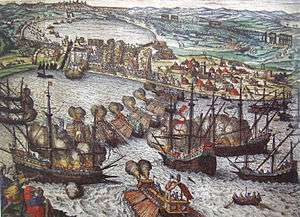Botafogo (galleon)
 The São João Baptista (on the left of the image), opening fire in the conquest of Tunis | |
| History | |
|---|---|
| Name: | São João Baptista |
| Builder: | Kingdom of Portugal |
| Launched: | 1534 |
| General characteristics | |
| Class and type: | Galleon |
| Displacement: | 1,000 tons |
| Armament: | 366 cannons |
The São João Baptista (English: Saint John the Baptist), commonly known as the Botafogo (Spitfire), was a Portuguese galleon warship built in the 16th century, around 1534, considered the biggest and most powerful warship in the world at the time.[1]
This ship could carry 366 bronze cannons, and had an artillery power of 1,000 tons. For this reason, it became known as Botafogo, meaning literally fire maker or spitfire in popular Portuguese.
History
The Botafogo was used both in the Atlantic and in the Mediterranean, where it became famous during the Conquest of Tunis (1535). In that battle, the Botafogo was commanded by Infante Luís, Duke of Beja, brother of John III and brother-in-law of Charles V.
According to historians, it was the Botafogo spur ram that broke up the chains at La Goletta, which defended the port entrance of Tunis, allowing the Christian allied fleet to reach and conquer the city.[2]
Botafogo in Rio de Janeiro
The galleon Botafogo is in the origin of the name of the famous Botafogo district in Rio de Janeiro, Brazil.
One member of the crew named João de Sousa Pereira, a noble from the city of Elvas, became famous because he was responsible for the ship's artillery, and he also got the nickname of Botafogo, which he later included in his family name. Later, he went to live in the Portuguese colony of Brazil, fighting against the French and the local Tupi Indians. As a reward, the Portuguese Crown granted him some lands known today as the Botafogo area.
References
- ↑ Spanish Galleon: Notable Galleons - Serving History
- ↑ Panorama (1841) Vol.5 , pp.384.
External links
Bibliography
- "Batalhas e Combates da Marinha Portuguesa", Vol. II, pages 243/245 – from Saturnino Monteiro. Livraria Sá da Costa, 1st edition, 1991.
- "Nobreza de Portugal e do Brasil" – Vol. I, pages 382/384. Published by Zairol Lda., Lisbon 1989.